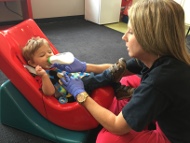
The following can be used to make sure that babies and children are fed in a safe position, minimizing the risk of food or drink entering their airway.
1. Don’t lay baby flat on his or her back while bottle feeding.
When bottle-feeding, it is important for the baby to be in a safe position. If you are unable to hold the baby while you feed him, remember to have him propped up so that he is not flat on his back while drinking the bottle.
2. Use side lying during bottle feeding to slow rate of milk flow.
If a baby has difficulty while taking the bottle and seems to have trouble coordinating his sucking and breathing, he may need to be fed slower. This can be done by allowing the baby to be positioned in side lying during bottle-feeding so the flow of milk from the bottle comes at a slower rate.
3. Use a safe spoon feeding position.
Babies and children should be spoon fed in a safe position. This can be while sitting up, propped up, or while you are holding them. The head should be in good position; it should not be tilted too far forward or too far backward during feeding. If the child is unable to hold his head in the best position for feeding, you should use your arm or something to prop his head.
4. Spoon feed from the side.
If a child is having difficulty accepting a spoon, one method of helping him is sitting to the side of the child and presenting the spoon from the side of his mouth.
5. Think small while spoon feeding.
In some cases, it may be beneficial to use a smaller spoon to present the food or to give the child a smaller amount of food at a time.
6. Keep child propped up after bottle or spoon-feeding.
It is important that babies or children remain propped up or sitting up for at least 30 to 60 minutes after they are finished eating. This can help decrease spitting up after feeding as well as keep food and liquid from entering the airway.
 Connie Clark serves as one of Children’s Therapy TEAM’s Feeding TEAM leaders, a multidisciplinary TEAM of professionals dedicated to evaluating and treating feeding and swallowing disorders in children. Special thanks to Children’s Therapy TEAM speech-language pathologist Amy Smith for collaborating in writing this post.
Connie Clark serves as one of Children’s Therapy TEAM’s Feeding TEAM leaders, a multidisciplinary TEAM of professionals dedicated to evaluating and treating feeding and swallowing disorders in children. Special thanks to Children’s Therapy TEAM speech-language pathologist Amy Smith for collaborating in writing this post.
